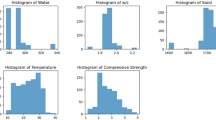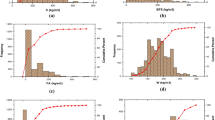Abstract
With complex limit state functions and small failure probability, the analysis of engineering structure reliability is a challenging problem. Most of the traditional methods require a lot of calculation time, which results in delaying the progress of solving engineering. To overcome this issue, a new structural reliability analysis method aiming to select a set of better initial design of experiment (DoE) is proposed in this study. The proposed method combines a weighted sampling based on sample probability and a novel selection strategy to select DoE and conduct active learning. Weighted sampling based on sample probability density makes the DoE uniformly distributed in the sampling space. The novel selection strategy is proposed to make selected DoE near limit state surface (LSS) and has better predictive ability. Numerical examples and engineering examples show that this method can perform energy efficiency analysis in important areas. The results show that the method is accurate and efficient in solving low failure probability and nonlinearity problems.
Similar content being viewed by others
References
D. Yang, Chaos control for numerical instability of first order reliability method, Communications in Nonlinear Science and Numerical Simulation, 15(10) (2010) 3131–3141.
J. E. Hurtado and D. A. Alvarez, A method for enhancing computational efficiency in Monte Carlo calculation of failure probabilities by exploiting FORM results, Computers & Structures, 117 (2013) 95–104.
R. Rackwitz and B. Fiessler, Structural reliability under combined load sequences, Computers & Structures, 9 (1978) 489–494.
B. K. Low, FORM, SORM, and spatial modeling in geotechnical engineering, Structural Safety, 49 (2014) 56–64.
J. C. Mitteau, Error evaluations for the computation of failure probability in static structural reliability problems, Probabilistic Engineering Mechanics, 14(1) (1999) 119–135.
B. Keshtegar and O. Kisi, M5 model tree and Monte Carlo simulation for efficient structural reliability analysis, Applied Mathematical Modelling, 48 (2017) 899–910.
B. Nie, S. Xu and Y. Wang, Time-dependent reliability analysis of corroded steel beam, KSCE Journal of Civil Engineering, 24 (2020) 255–265.
P. P. Zhi et al., Bounds-based structure reliability analysis of bogie frame under variable load cases, Engineering Failure Analysis, 114 (2020) 104541.
G. I. Schuëler, H. J. Pradlwarter and P. S. Koutsourelakis, A critical appraisal of reliability estimation procedures for high dimensions, Probabilistic Engineering Mechanics, 19(4) (2004) 463–473.
H. J. Pradlwarter et al., Application of line sampling simulation method to reliability benchmark problems, Structural Safety, 29(3) (2007) 208–221.
S. K. Au and J. L. Beck, Estimation of small failure probabilities in high dimensions by subset simulation, Probabilistic Engineering Mechanics, 16 (2001) 263–277.
V. Papadopoulos et al., Accelerated subset simulation with neural networks for reliability analysis, Computer Methods in Applied Mechanics and Engineering, 223–224 (2012) 70–80.
R. E. Melchers, Radial importance sampling for structural reliability, Journal of Engineering Mechanics, 116(1) (1990) 189–203.
S. K. Au and J. L. Beck, Importance sampling in high dimensions, Structural Safety, 25 (2003) 139–163.
V. Dubourg, B. Sudret and F. Deheeger, Metamodel-based importance sampling for structural reliability analysis, Probabilistic Engineering Mechanics, 33 (2013) 47–57.
L. Faravelli, Response — surface approach for reliability analysis, Journal of Engineering Mechanics, 115(12) (1989) 2763–2781.
D. L. Allaix and V. I. Carbone, An improvement of the response surface method, Structural Safety, 33(2) (2011) 165–172.
S. K. Sachdeva, P. B. Nair and A. J. Keane, Hybridization of stochastic reduced basis methods with polynomia chaos expansions, Probabilistic Engineering Mechanics, 21(2) (2006) 182–192.
Y. C. Zhou, Z. Z. Lu and W. Y. Yun, Active sparse polynomial chaos expansion for system reliability analysis, Reliability Engineering & System Safety, 202 (2020) 107025.
C. W. Fei et al., Multilevel nested reliability-based design optimization with hybrid intelligent regression for operating assembly relationship, Aerospace Science and Technology, 103 (2020) 105906.
C. W. Fei et al., Enhanced network learning model with intelligent operator for the motion reliability evaluation of flexible mechanism, Aerospace Science and Technology, 106 (2020) 106342.
H. M. Gomes and A. M. Awruch, Comparison of response surface and neural network with other methods for structural reliability analysis, Structural Safety, 26(1) (2004) 49–67.
Y. Ren and G. C. Bai, New neural network response surface methods for reliability analysis, Chinese Journal of Aeronautics, 24 (2011) 25–31.
G. Matheron, The intrinsic random functions and their applications, Advances in Applied Probability, 5(3) (1973) 439–468.
C. Lu et al., Improved decomposed-coordinated kriging modeling strategy for dynamic probabilistic analysis of multicomponent structures, IEEE Transactions on Reliability, 69(2) (2020) 440–457.
C. Lu et al., Moving extremum surrogate modeling strategy for dynamic reliability estimation of turbine blisk with multi-physics fields, Aerospace Science and Technology, 106 (2020) 106112.
C. W. Fei, C. Lu and R. P. Liem, Decomposed-coordinated surrogate modeling strategy for compound function approximation in a turbine-blisk reliability evaluation, Aerospace Science and Technology, 95 (2019) 105466.
C. W. Fei et al., Dynamic parametric modeling-based model updating strategy of aeroengine casings, Chinese Journal of Aeronautics (2021).
C. W. Fei et al., Whole-process design and experimental validation of landing gear lower drag stay with global/local linked driven optimization strategy, Chinese Journal of Aeronautics (2020).
B. Echard, N. Gayton and M. Lemaire, AK-MCS: an active learning reliability method combining Kriging and Monte Carlo simulation, Structural Safety, 33 (2011) 145–154.
S. N. Xiao, S. Oladyshkin and W. Nowak, Reliability analysis with stratified importance sampling based on adaptive Kriging, Reliability Engineering & System Safety, 197 (2020) 106852.
L. X. Hong et al., A novel kriging based active learning method for structural reliability analysis, Journal of Mechanical Science and Technology, 34(4) (2020) 1545–1556.
J. H. Zhang, M. Xiao and L. Gao, An active learning reliability method combining Kriging constructed with exploration and exploitation of failure region and subset simulation, Reliability Engineering & System Safety, 188 (2019) 90–102.
Z. L. Xiang et al., An active learning method combining deep neural network and weighted sampling for structural reliability analysis, Mechanical Systems and Signal Processing, 140 (2020) 106684.
P. J. Zheng et al., A new active learning method based on the learning function U of the AK-MCS reliability analysis method, Engineering Structures, 148 (2017) 185–194.
M. Sasena, Flexibility and Efficiency Enhancements for Constrained Global Design Optimization with Kriging Approximation, University of Michigan, USA (2002).
Z. Sun et al., LIF: a new Kriging based learning function and its application to structural reliability analysis, Reliability Engineering & System Safety, 157 (2017) 152–165.
N. Lelievre et al., AK-MCSi: a Kriging-based method to deal with small failure probabilities and time-consuming models, Structural Safety, 73 (2018) 1–11.
P. S. Efraimidis and P. G. Spirakis, Weighted random sampling with a reservoir, Information Processing Letters, 97(5) (2006) 181–185.
L. Schueremans and D. V. Gemert, Benefit of splines and neural networks in simulation based structural reliability analysis, Structural Safety, 27(3) (2005) 246–261.
S. K. Au, J. Ching and J. L. Beck, Application of subset simulation methods to reliability benchmark problems, Structural Safety, 29(3) (2007) 183–193.
A. R. Nowak and K. R. Collins, Reliability of Structures, Boston: McGraw-Hill, New York, NY (2000) USA.
H. S. Li, Z. Z. Lv and Z. F. Yue, Support vector machine for structural reliability analysis, Applied Mathematical Modelling (English Edition), 27(10) (2006) 1295–1303.
Acknowledgments
This work was sponsored by the Fund for National Natural Science Foundation of China (51805348), sponsored by the Fund for Shanxi “1331 Project” Key Subjects Construction.
Author information
Authors and Affiliations
Corresponding author
Additional information
Yang Ruigang received the B.S. degree in Mechanical Engineering from Taiyuan University of Technology, in 1998 and the Ph.D. degree in Mechanical Engineering from Taiyuan University of Technology, in 2009. He is a Professor of Taiyuan University of Science and Technology of China. He has published more than 50 journal articles and conference papers.
Rights and permissions
About this article
Cite this article
Li, W., Yang, R., Qi, Q. et al. A novel structural reliability method based on active Kriging and weighted sampling. J Mech Sci Technol 35, 2459–2469 (2021). https://doi.org/10.1007/s12206-021-0517-0
Received:
Revised:
Accepted:
Published:
Issue Date:
DOI: https://doi.org/10.1007/s12206-021-0517-0




